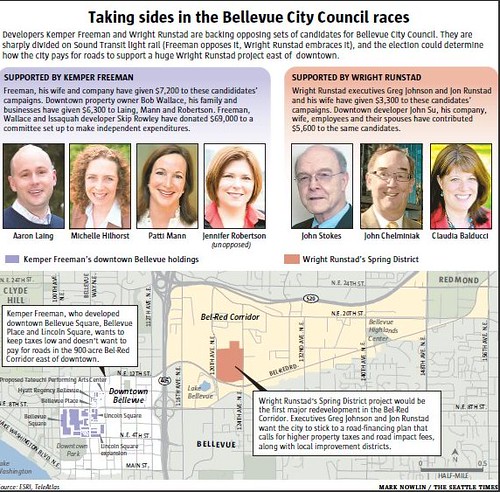Election positions as proxies for the "growth machine" and big business
I had forgotten to write about Bellevue, Washington in the context of this week's election. Different initiatives became proxies for pro- or anti- transit positions. But pro- vs. anti-transit positions are most often positions about greenfield development ("sprawl") vs. more intensified development in already existing places.
Or about the politics, policies, and subsidies for greenfield development come at the expense of maintaining healthy cities. (See "The American suburbs are a giant Ponzi scheme" by Charles Marohn of the Strong Towns Institute, via Grist.)
In Bellevue, real estate developer and shopping mall owner Kemper Freeman Jr. doesn't want to see light rail service, because he sees that as disadvantegous to his investments, even though they'd benefit from the addition of transit service. He is a fervent supporter of automobility.
So he bankrolled (gave $1.1 million) Washington State's leading referendum gadly Tim Eyman's initiative to limit tolling on freeways (I-1125, which lost), to put authority for rate increases within the State Legislature instead of an independent toll authority (which is how it is done everywhere else, and not related to tolling, a provision in I-1125 would have banned use of the I-90 bridge for light rail service to Bellevue and Redmond, Washington.
Simultaneously, Freeman backed challengers with anti-transit positions in the Bellevue City Council election.
...Land-use decisions are rarely free of such battles for influence, whether one sees it as a business fighting for its legitimate interests or the American sprawl machine at work, resulting in what urbanist James Howard Kunstler has called "perhaps the greatest misallocation of resources in the history of the world."
In Bellevue's case, especially thanks to the reporting of The Seattle Times' Keith Ervin, the machinations are out in the open.
Kemper Freeman Jr., who along with his father created much of today's Bellevue, wants politicians friendly to his plans to continue building downtown. If you haven't noticed, he fiercely opposes light rail and is spending money on anti-rail candidates, as well as a reported $1.1 million to support Initiative 1125 on tolling, which also seeks to kill light rail to the Eastside.
In the other corner is Wright Runstad, which wants to build 36 acres of transit-oriented development on the Bel-Red Corridor, between downtown and Microsoft's headquarters in Redmond.
You can see Freeman's point, that intense development in the core is better, and you could argue that the Runstad development is a form of sprawl. But in any case, relying on auto-centric transportation for the future, as demand for oil increases globally (even with increases in supply, specifically in the U.S., from improved production technology, prices will increase to a point where sprawl is even more uneconomic) is an unsustainable strategy.
Also see "Bellevue council elections divide developers," "Kemper Freeman helps fund mailer targeting Bellevue candidate John Stokes," "Light-rail views drive Bellevue council races," "Balducci second target of campaign by Freeman, others," and "Laing, Stokes in tight battle for council seat."
For once I'd like to see reporting like this in the Washington Post.
Labels: commercial district revitalization planning, elections and campaigns, electoral politics and influence, formula retail, Growth Machine, urban design/placemaking, voting and referendums




0 Comments:
Post a Comment
<< Home